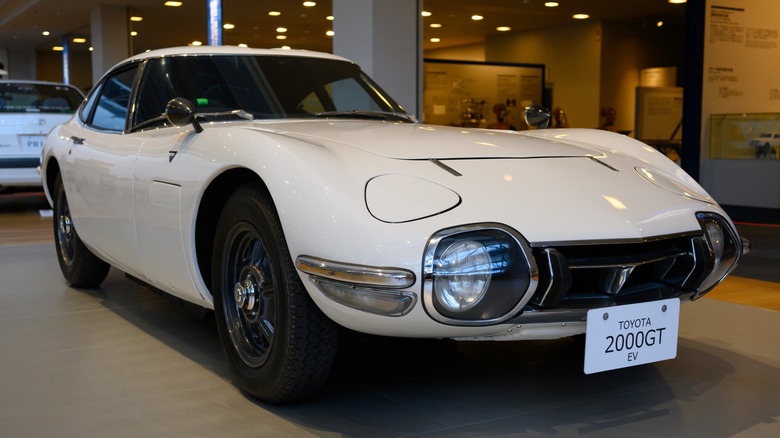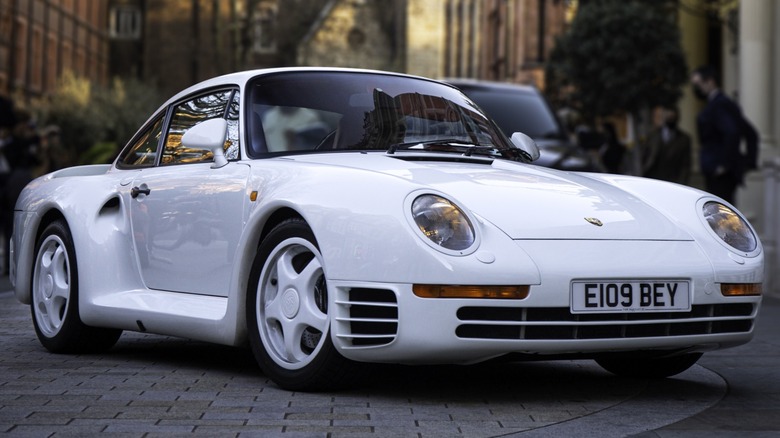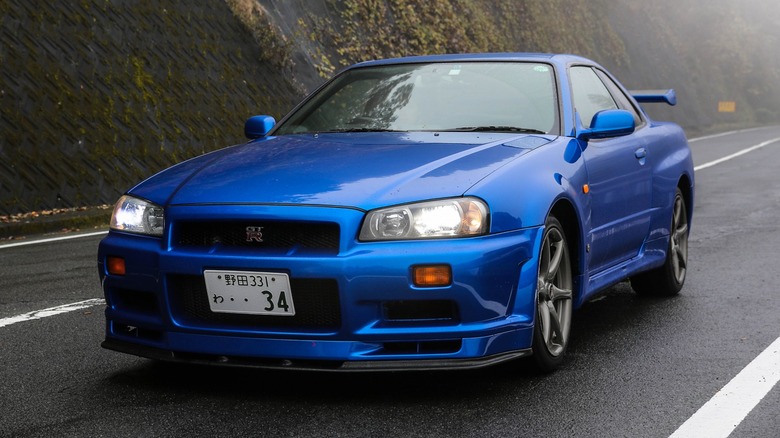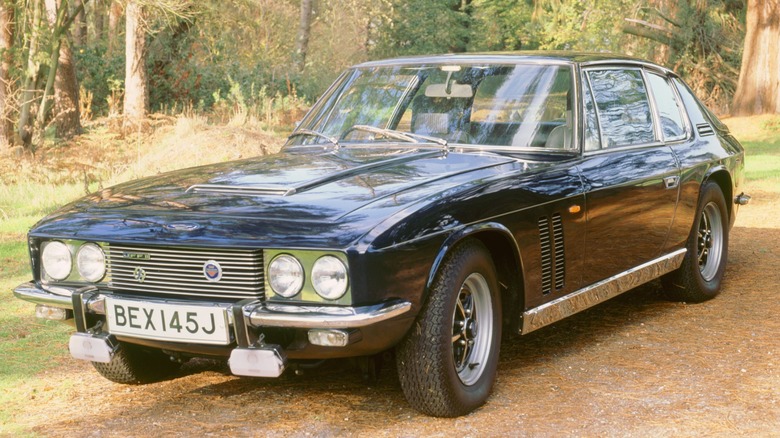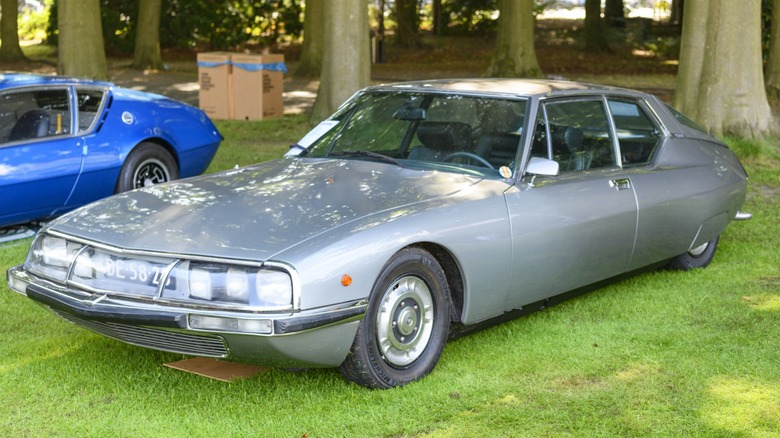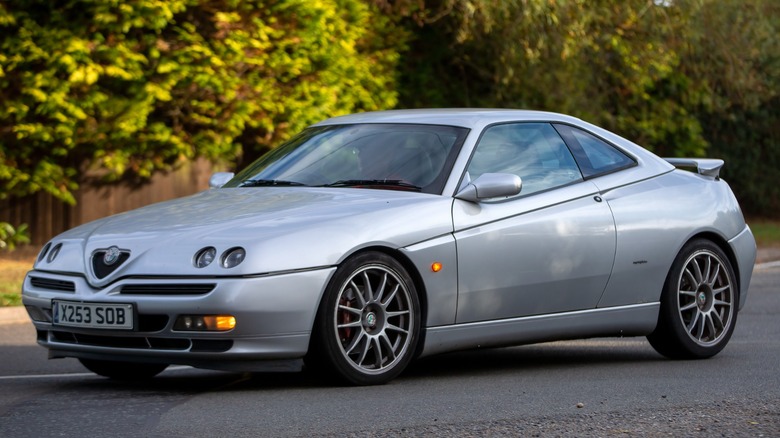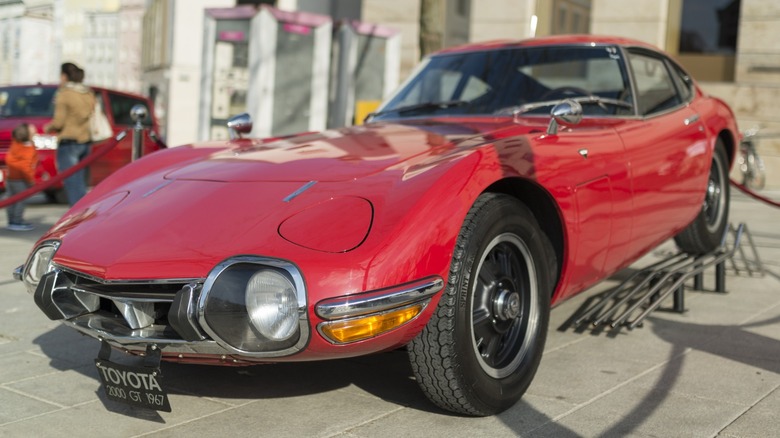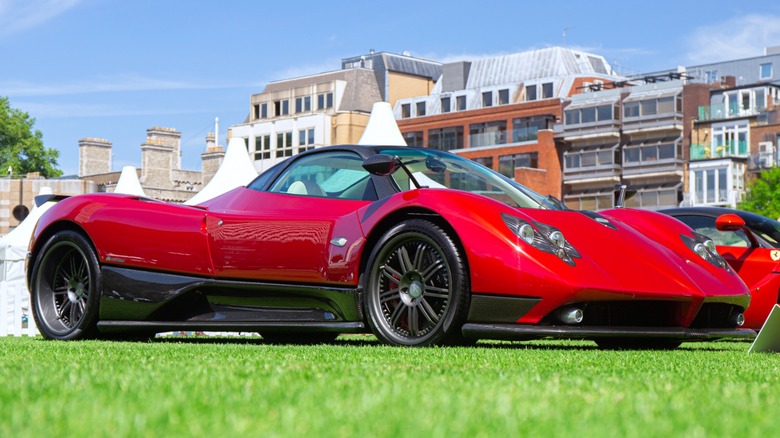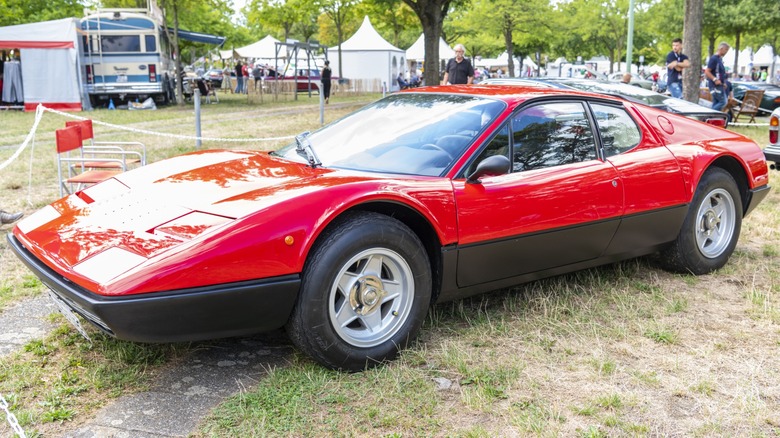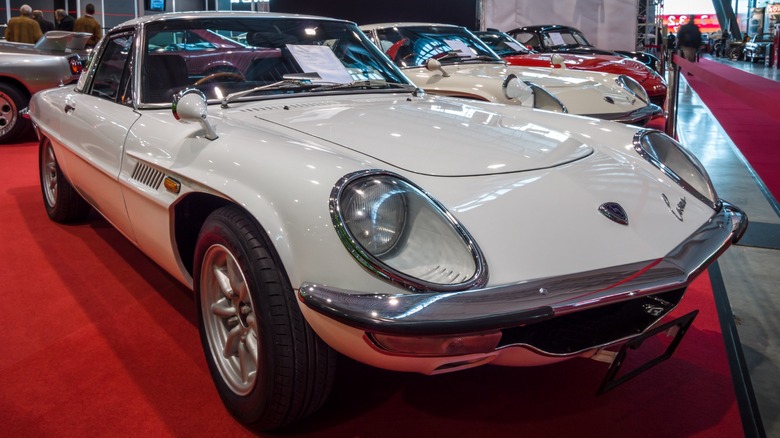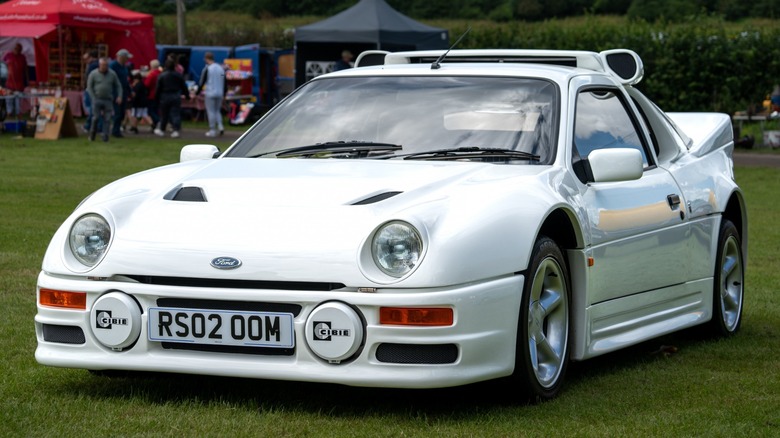10 Of The Coolest Cars You Couldn't Buy In America
Americans have never been short of a good selection of automobiles to buy. In the early days, there were dozens of automakers, and even in the early post-war period, there were still half a dozen. Even the big three have produced a wide range of cars to meet the needs of most buyers. Import cars represented a tiny percentage of auto sales up to 1950, but the booming post-war era brought in carmakers from war-ravaged countries that needed to expand sales. Naturally, America had plenty of demand. Max Hoffman introduced American buyers to imported cars when he set up distribution of Porsche, Jaguar, Volkswagen, Mercedes-Benz, Alfa Romeo, and others throughout the 1950s. Japanese brands soon followed, receiving a much-needed boost when their small and economical cars became viable alternatives during the energy crises of the 1970s.
Imported cars are now staples of American highways, and most manufacturers now build many models in domestic factories. However, throughout the second half of the 20th century (and even today), some of the best models are held back for their domestic consumption only. Sometimes that is because the cars are poorly suited for American highways and driving habits. Other times, federal regulations are too onerous and costly to bother with for low-volume cars, especially the sports car models.
This is the situation that often turns some very desirable cars into automotive forbidden fruit. Though any of these cars can be imported after 25 years, here is a selection of the coolest cars Americans couldn't buy when they were new.
Porsche 959
The ultimate 1980s Porsche was built at a time of increasing integration of electronics into automobiles. At the forefront of this technological revolution was Porsche, maker of the iconic 911 sports car. Planned as a road-legal car that would also be built to satisfy regulations so it could compete in Group B racing, the Porsche 959 broke ground in many ways in both engineering and performance. Its turbocharged flat-six 2.8-liter engine drove nearly 450 hp through all four wheels in a chassis full of alloys like titanium and magnesium to save weight. Furthermore, it used electronics to control the AWD system as well as the suspension, a first for a road car. It was also the first to have a tire pressure monitoring system, all thanks to advanced electronics.
When new in 1987, it was not legal for import and Porsche did not do the extensive testing required for entry into American ports. That didn't stop the likes of Jerry Seinfeld or Bill Gates from getting one of these ultimate Porsche specimens, they just could not drive them legally. However, through intensive lobbying efforts and plenty of hand-wrangling, they got Bill Clinton to sign a law that allowed cars to be imported under a "Show or Display" rule. This meant some limited-production cars of particular interest and value may be imported so long as they do not exceed 2,500 miles on public roads per year. The rule was also designed to limit the importation of a vehicle to 500 units per model.
Nissan Skyline GT-R
The '90s was an era of pushing the performance envelope by Japanese automakers. Advancements in electronics and engineering were making it possible to squeeze increasing amounts of power out of the engines without resorting to drastic increases in displacement. This is the era that gave us classics such as the Mitsubishi 3000GT VR4, Toyota Supra, and Acura NSX. Yet, while American drivers were drooling over the hot fast imports, only the Japanese were privy to the fastest Nissan available, the Skyline GT-R.
Nissan has been making a model called Skyline since 1957, but it was not introduced as a high-performance model. Originally dubbed the "Prince Skyline," it was offered as a premium sedan for the domestic market. But in 1969, Nissan added the GT-R trim option to the coupe version, which included a dual-overhead cam 2.0-liter 6-cylinder engine. The GT-R output was 160 hp, which was very good for its time as well as the size of the vehicle. The car continued to be a popular option, albeit only in Japan. It was when the 1999-to-2002 fifth-generation GT-R was featured in several movies in the "Fast and Furious" franchise that its popularity skyrocketed. This was further bolstered by its inclusion in many video games of the time, particularly "Gran Turismo."
Since then, the Skyline GT-R has been the favorite forbidden object of desire for many American drivers. Its styling is sharp and subdued, and the original power output of 276 hp makes it a good performer as well. With the 25-year mark fast approaching, imports of the most popular models will soon be more prevalent in America.
Jensen FF
Boutique automaker Jensen made a small number of GT cars with huge American engines over a few decades, ending in the late '70s. The most popular model was the Interceptor, a large and muscular car with a long nose and a well-appointed interior. Using it as a base, Jensen contracted Harry Ferguson Research Ltd. to develop an all-wheel-drive system. Ferguson had much experience with tractor development and had created the first all-wheel-drive Formula 1 car. With this system, Jensen created the first all-wheel-drive sports car, called Ferguson Formula, or "FF" for short.
The Jensen FF is a rarity for British cars as it was powered by a Chrysler 440 V8 with a Torqueflite automatic transmission. This setup was common for American cars like a Charger, but nearly unheard of on the medieval roads of Europe. Jensen used the gas-thirsty and European tax-heavy V8s for many years, creating some very fast yet elegant GT cars. It is speculated that when Audi wanted to build its highly successful Quattro system, engineers disassembled a Jensen FF to study its mechanicals before setting out to design their own.
Despite the elegance, sophistication, and innovation of this car, it failed to achieve much commercial success. The poor sales are likely largely owing to the position of the front differential preventing a left-hand-drive version, limiting sales to British customers only.
Citroën SM
Based on the groundbreaking DS model introduced in the '50s, the Citroën SM used all the best parts of the DS, swapped the engine for a more powerful Maserati unit, and then added a generous helping of luxury. Although it was built at an extraordinarily tumultuous time for the company, the end result is above reproach and truly sublime. It would be hard to find a person who has driven one for any amount of time to find a reason to complain about it.
In describing the SM, there is but one word to sum it up: quirky. Just like the DS before it, the SM is built like no other automobile. However, once you get behind the wheel and get a feel for it, you'll not want to leave. Inventive engineering is what ultimately sets it apart from the pack. The suspension is the now-famous Citroën hydropneumatic that works so well it is shared with contemporary Bentley vehicles, and the hydraulic pressure that feeds the suspension also feeds the steering, brakes, and clutch. The Maserati engine is mounted fully behind the axle, making this mid-engined, and it offers 181 hp, which is more than enough.
The interior of the SM is a bit more sedate than the intergalactic leanings of the exterior design and filled with thick and plush seats appropriate for a cross-country journey. The headlights also turn with the steering. However, that feature is among the reasons it was never exported to the U.S. Strict and archaic headlight regulations of the day prevented this Gallic masterpiece from arriving on our shores.
Alfa Romeo GTV
Alfa Romeo entered the American market around the same time as other European brands, but in 1994, its 164 sedan was the last model to be sold in the country for two decades. Though the brand has since returned, Americans missed out on several models, including some with styling that could have come from no other brand and from no other time. One model we missed is the 1995-to-2003 GTV.
It is possible the styling of the GTV is one that people either love or hate. It is unusual and it looks very much like it belongs in a shopping mall circa 1997. The car is angular and sleek, with a cut that wraps around the back. The car also has tiny round quad headlights and a Kammback-style rear end. Looking at it, you can see it is unmistakably "Alfa." The car is powered by a 2.0-liter 16V Twin Spark with a modest 152 hp, but this car is not about winning races, but having fun through the bends and looking good in the process.
The interior of the GTV is upscale and attractive, offering a stylish alternative to the BMW Z3, though the Alfa also has rear seats. The Alfa GTV was built to be a fun car that could also be used to commute. The build quality is probably typical Alfa of the '90s, which is to say, subpar at best. However, nobody buys an Alfa for the build quality, but rather its cosmetic appearance.
Toyota 2000GT
Long before a Camry or Corolla represented every other car in a Wal-Mart parking lot, Toyota represented a minuscule portion of the American auto market. Yet, while the company was setting out to dominate the world, it created what might be the perfect sports car, the 2000GT.
In the '60s, Toyota needed to build a car that could build its image as a serious automaker rather than that of a toy builder. At the time, Yamaha had been developing a prototype for Nissan but that project was canceled. It was then offered to Toyota and approved to go ahead. The economic case for building a sports car at that time was not financially sound but Toyota went into the project with a mandate to build the best car possible however necessary.
The car they built came out for the 1967 model year featuring a 2.0-liter Toyota inline-six fitted with a dual-overhead-cam head engineered by Yamaha. The car was hand-built by a team of Toyota's best engineers and designers, resulting in perhaps the finest piece of machinery to ever come out of Japan. It looked stunning, performed well, and had great handling to match. But most of all, it looked like nothing Toyota had ever made before and wowed the automotive press of its day. It even received a publicity boost by being included in the James Bond film, "You Only Live Twice," which was set in Japan. Only 351 copies were built exclusively for the Japanese market.
Pagani Zonda
When Lamborghini designer Horacio Pagani found difficulty getting some of his ideas included in new models, he chose to strike out on his own and build his own car, free from all restrictions. Pagani mostly wanted to work with composite materials to create elegant and lightweights cars, so he created the Pagani Composite Research company, which is where plans for an original car were laid. This resulted in a prototype by the mid-'90s and a car ready for sale in 1999, the Zonda, named for winds from the hills of Argentina, his homeland.
When the Zonda debuted, it stunned everyone who saw it. It had a body with sculpted lines that merge the best of a purpose-built race car and an elegant road-legal cruiser. To say it was stunning is an understatement, it was a work of art. This continued inside the car, where the finest attention to detail and quality was evident on every surface and in every crevice. The first models were equipped with Mercedes-Benz AMG V12 engines making around 400 hp. Given the lightweight chassis of the Zonda, the packed-in power made it incredibly quick. However, subsequent updates would raise the power to more than 800 hp, making them ludicrously quick.
Pricing of the first Zondas started around $350,000, but the bespoke-built cars soon crossed the $1 million threshold as Pagani built his brand. Furthermore, Pagani only built a handful of cars each year and never had them certified for use on American roads, leaving them to be imported only under the "Show or Display" rules. However, Pagani had its successor, the Huayra, certified for U.S. export.
Ferrari 365 GT4 BB
Although Ferrari was the leading name in high-end sports cars in the '50s and '60s, upstart Lamborghini made for genuine competition, especially when it presented its mid-engine Miura in 1967. As a response to Lamborghini and to keep up with the market, Ferrari developed the 365 GT4 BB, which went on sale in 1973.
The 365 GT4 BB used an engine setup that had been proven on the race track already, a flat-12, mounted in the rear of the chassis. This engine choice helped to keep weight lower and its position in the car put most of the weight between the wheels. With its all-aluminum construction and dual overhead camshafts, it was good for 339 hp. In a first for Ferrari, the BB was built with a semi-monocoque chassis having tubular steel subframes attached to a single-piece passenger compartment. The result of this setup made the BB one of the best-handling cars of its day. Inside, drivers were treated to typical Ferrari elegance replete with ample leather and fashionable, yet functional gauges and switchgear.
The BB, or Berlinetta Boxer, was an inflection point for Ferrari and signaled the wave of mid and rear-engine Ferrari supercars to come. However, it was built at a time when an energy crisis was in full swing and lawmakers in the U.S. passed regulations to reduce consumption. Because of this, Enzo Ferrari saw no point in sending this svelte performance car to a country with a national speed limit of just 55 mph.
Mazda Cosmo Sport 110S
Although Mazda is well known for its reliable and fun-to-drive cars as well as its pioneering rotary engines, its best-kept secret is ironically its first sports car, the Cosmo Sport 110S. When engineers at Mazda started developing an original version of the Wankel rotary engine, Mazda needed a car in which to introduce it. Rather than putting it in an existing sedan or other small car typical of the company, they chose to create a new sports car to serve as a showcase for the new technology.
The purpose of the Cosmo was not to create and build a profitable car line, but something with value in publicity and getting the attention of the press. Prototypes were introduced in 1963 but engineers still needed to perfect the two-rotor engine. By 1967, a production car was ready and went on sale in Japanese right-hand-drive versions only. The car did garner the attention wanted and the automotive press gave it high praise, deservedly so. The space age styling was sleek and rounded, making the little Mazda look like a cross between rocket and spaceship. As a hand-built car in a custom workshop from 1967 to 1972, only 1,176 were produced in two series in total, making them rare and valuable today.
The Cosmo name was revived in 1975 and used in successive cars that would be more conventional models. However, the last usage of the name came in 1990 for a super premium GT car fitted with the only production three-rotor engine ever mass-produced. These were also turbocharged and outfitted with luxury interiors, representing the best the brand had to offer in the '90s, albeit only in Japan.
Ford RS200
WRC Group B rally racing was a popular division of the sport until tragedy struck in 1986. Fatal accidents during races in Portugal and Corsica led to the abrupt end of Group B. Ford had been racing in the WRC rally with various iterations of its Escort — the European version — with much success. Ford also wanted to debut a car in Group B, creating a mid-engined vehicle for homologation to satisfy the rules and enter the race. The RS200 competed in 1985, but with Group B suddenly canceled the next year, Ford was left holding the bag with a car meant for a race that no longer existed.
Group B rules stipulated that 200 road-legal cars had to be built by Ford to qualify. Although Ford may have had more cars in the works, the company never followed through, leaving an impossibly small amount of fantastically cool little cars for the Earth's enjoyment forevermore. The RS200 had a 2.1-liter Cosworth turbocharged inline-4 that sent 600 hp to all four wheels. With a weight of just 2,600 pounds and the engine positioned behind the seats, the handling was superb. Furthermore, it is still just a fantastic-looking little car with 1980s styling that hasn't aged a bit. However, the interiors of the cars remained a bit sparse, and attempts to get them ready quickly left quality a bit to be desired, especially as they sold for £50,000 in 1986 money, more than a Ferrari 328 at the time.
With the demise of Group B, Ford had 24 additional cars on hand for racing and chose to convert the rest to road-legal cars, leaving a total production of 224. The time that they can be imported has long since passed, but buying one today will cost you a few hundred thousand dollars.
